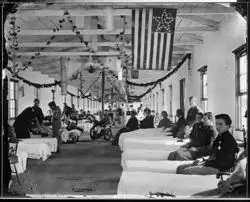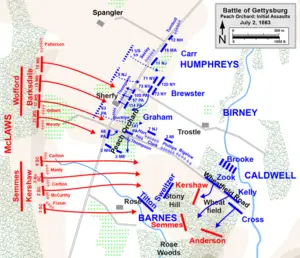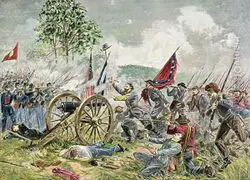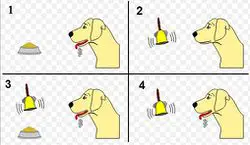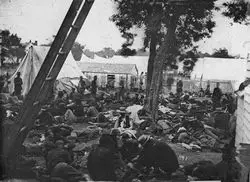Difference between revisions of "How Did God Influence the Wounded in the American Civil War"
m (Admin moved page How Did God Influence the Wounded in the American Civil War? to How Did God Influence the Wounded in the American Civil War) |
|
(No difference)
| |
Latest revision as of 03:21, 21 September 2021
“Surely the Almighty’s hand was in this.”[1]This was the immediate thought of Private William McCarter after discovering that the blanket he had used to shield his head contained 47 musket balls. On December 13, 1862, McCarter survived the Battle of Fredericksburg lying prone and bleeding on the battlefield, armed with a blanket and a prayer. After being shot in the upper arm, the private deemed his situation to be hopeless. He proceeded to pray, which at the time was his only means of solace. After praying he “felt more composed in [his] mind and perfectly reconciled to [his] fate”[2] How can a few words to an unproven entity ease a man’s mind and perhaps heal his body? Was the reason for McCarter’s survival supernatural or was it strictly science? Perhaps it was both. A conditioned belief in the power of supernatural intervention is responsible for the scientific explanation of supposed medical miracles. McCarter was far from alone as a miraculous survivor of the bloodiest of all American wars. Although Fredericksburg was a horrific battle, the one seven months hence caused even greater suffering; it occurred on a farm in an obscure Pennsylvania town.
Private William Estee
The first three days of July, 1863 witnessed the greatest amount of American blood spilled in a single battle. Of the more than 165,000 men who engaged in battle during those three days, over 51,000 became casualties of war. Two men in particular deserve attention for the purposes of this discussion; Union Private William Estee and Confederate Brigadier General Lewis Armistead. At twenty-one years of age, Estee was little more than a boy when he was mustered into the 5th Massachusetts Light Artillery on December 3, 1861. Less than two years later he found himself hotly engaged in battle at Gettysburg.[3]
On July 2, 1863 Estee and the 5th Massachusetts Light Artillery was caught in the dreadful “battle of the wheat field.” As Estee raised his arms to load a cannon, a Confederate rifle ball “struck him in the abdomen.”[4] He was able to hold pressure on his wound and make his way to the division hospital. The severity of his wound was not immediately apparent. It was not until he was prepared for evacuation to a general hospital in Baltimore that the gravity of his situation was understood. The attendants at the field hospital found Estee lying in the fetal position. When they attempted to lower his legs in order to move him onto the ambulance——which at the time consisted of either a two or four horse buggy——he maintained his rigid hold on his knees and moaned in pain. He had been “unable to eat and perspired profusely and continually.”[5] The orderlies managed to load Estee onto the ambulance and subsequent rail car. He endured the trip from Gettysburg to Baltimore with his grossly distended abdomen bouncing on the wooden floor of a boxcar.
When he finally arrived at Jarvis General Hospital he was “feverish and almost delirious”[6]The private had developed peritonitis as a result of his abdominal wound. As defined by the National Institute of Health, peritonitis is the inflammation of the peritoneum, the thin covering encompassing the abdominal cavity. Estee had what is known as secondary peritonitis resulting from a perforation of the bowel due to the gunshot wound. Without the advantage of modern technology, the attending physician diagnosed Estee by virtue of his classic peritonitis symptoms; abdominal pain and distention, loss of appetite, and fever. De Witt C. Peters, the surgeon in charge at Jarvis General, noted in his report that upon examination the “abdomen was tender and tympanic, the knees drawn up, the breathing difficult.” Peters also noted that fecal matter escaped from both the entrance and exit wounds. Upon the introduction of a catheter, he observed the output of “urine and fecal matter.”[7] The doctor was convinced of severe peritonitis and informed Estee that “his wound was mortal and he would soon die.”[8] Estee was wounded on July 2 and received only battlefield first aid before arriving at Jarvis general on July 13, 1863.
Brigadier General Lewis A. Armistead
Confederate Brigadier General Lewis Armistead was wounded one day after Estee. Armistead was a man in his early forties and a seasoned military veteran. He had attended West Point with some of the same men against whom he fought. Armistead is best remembered for his gallant attempt to breach Union lines on July 3, 1863, as a member of the ill-fated “Pickett’s Charge.” As he reached the Union artillery, with his hat wielded high upon his sword, he was shot through the “fleshy part of the arm” and in the “right leg.”[9] Unlike Estee, his wounds were seemingly innocuous, albeit painful.
Armistead received his wounds on the final day of battle at Gettysburg. The general’s brigade penetrated the Union lines further than any other during the doomed charge. General Pickett’s division contained three brigades totaling 5,820 men. Of this number, little more than half (3,180) returned safely to their lines[10] General Armistead represented a number in all of the statistical columns: killed in action, wounded in action, and captured in action. On the brink of Confederate immortality, Armistead, “hat on the hilt of his sword,” breached the Union's line.[11] As the general reached the second line of Federal guns, he placed his hand upon the barrel of a cannon and shouted to his men, “The day is ours. Turn these guns upon them, boys.”[12]Almost immediately after the triumphant words left his mouth, he fell at the hands of a Union rifle.
By all accounts, Armistead’s wound was not thought to be mortal. He was treated at a Union field hospital by Dr. Daniel Brinton. The doctor believed that although amputation was probable, Armistead had a very good chance of survival as "no arteries had been severed."[13] When Armistead was treated at the XI Corps hospital, Dr. Henry Hendrick reported that “‘He had lost quite a deal of blood, but the wounds were not necessarily fatal. He never rallied, however, and died a little past noon on the Fourth of July’”[14]We are now presented with two men and two wounds. One was expected to live while the other was told he would die. Some science is needed to understand the surprising turn of events.

Science
When the human brain expects something to occur, metabolic and chemical processes begin. For example, when one suffers a headache and decides to ingest aspirin, a conditioned chemical response transpires in the brain prior to the pills being taken. As this person has been conditioned to believe that aspirin will cure her headache, the simple anticipation of relief increases the metabolic process, thus increasing blood flow to the brain. In a study presented in the “Journal of Neuroscience,” it has been discovered that “drug effects are reduced if expectations are absent.” (Benedetti et al, 2005). Blind studies measured the neurobiological effects of a placebo as treatment. One conclusion drawn by the group of neurologists was, “The expected administration of a drug has a more powerful effect on brain metabolism than the unexpected administration.”[15] The study was conducted using a pain stimulus and the subjects received either pain medication or a placebo. Those who received the placebo reacted similarly to those who received an actual opioid. In sum, the test subject believed he was receiving pain medication, thus his cerebellum acted as if he had.
The phenomena that have been discovered in neurobiological testing can occur only if the subject has been conditioned to have a certain response to a specific stimulus. This can be illustrated via the classic example of Pavlov’s Dogs. The scientists conditioned the dogs to respond to a stimulus (a bell) in the same way that headache sufferers have been conditioned to respond to aspirin. When the dogs heard the bell they began to salivate as they were conditioned to expect food after the bell sounded. When one who has a headache envisions a bottle of aspirin (stimulus), she has unconsciously set in motion a series of neurological events that result in physical change--- this is the equivalent of salivation. Whether or not the food is presented, once conditioned the dogs will salivate at the sound of the bell. The same is true with the example of the headache sufferer; once the idea of relief enters into consciousness the brain involuntarily instigates metabolic and chemical reactions.
Philosophy
Like other animals, humans are also classically conditioned. So-called "sugar pills' are not the only form in which placebos present themselves. God can also act as a placebo, or rather, it is the conditioned belief in God that can generate the placebo effect. In essence, a conditioned belief comes from knowledge. The late physicist and philosopher, Ian Barbour asserted, "Science seems to provide the only reliable path to knowledge."[16] Barbour may be correct; however, if knowledge can be defined as answers gained through experience, whether real or imagined, science is not the only answer. Private Estee was not a man of medicine or any other scientific discipline.
At the time he enlisted in the army he was working as a teamster. His recovery, after being told by a man of science that he was sure to die, must have appeared as nothing less than a true miracle that stemmed from divine intervention. Philosopher Michael Ruse very eloquently opines that "A miracle is less something that is a violation of physics, say, and more something that means something to people at the time or later."[17] It can therefore be argued that Estee created his own miracle while Armistead had no such will to live.
The Outcome of the Wounds
Lewis Armistead was wounded only yards from his long-time friend, General Winfield Scott Hancock. The two attended West Point together and served alongside one another at several military posts in the West. Hancock remained loyal to the Union while Armistead chose to honor his home in Virginia and was commissioned in the Confederate Army. Both men were wounded during Pickett’s charge on July 3, 1863. Physically, and following amputation, Armistead's prognosis was excellent. His psychological distress at the time of his injury may have greatly contributed to his demise.
Shortly after being shot, he requested that a message be conveyed to his old friend, Hancock. Although there has been some controversy as to the meaning of the message, Armistead’s intent was to apologize to his friend. He asked a member of Hancock’s staff to “Tell General Hancock for me that I have done him and done you all an injury which I shall regret the longest day I live."[18] He was a morose figure, slumped against a wall, who had lost the will to live. His synaptic firings were exuding a sense of impending doom as opposed to Estee’s, whose were clearly instilling an opioid effect. Estee had administered his own placebo, whether it came in the form of God or something else, may never be discovered.
Private Estee did not leave a memoir detailing his thoughts or beliefs; however, it can be extrapolated from the circumstances that he did in fact have a strong determination to survive. After suffering a significant abdominal wound in the Wheatfield, he managed to walk unassisted to the rear of the battle line in order to obtain first-aid treatment. He suffered for more than ten days with a wound that by all accounts was expected to kill him. It can be concluded from Estee's courageous tenacity that his will to live triggered a physiological response in his body.
Conclusion
“Altogether his case was thought to be hopeless, and I so informed him, as I thought peritonitis of an aggravated form had set in.” This was written by Dr. De Witt Peters in an article published in the “American Medical Times," January 1864.[19]Among the several cases pertaining to the Battle of Gettysburg on which Peters lectured, he always included the Estee case. Even today, untreated peritonitis is fatal. Treatment after waiting for a long period of time is lethal on more than nine out of ten occasions. When given the details of Estee’s case, several medical professionals that were interviewed agreed there was no known medical reason that he survived. When asked her opinion on why she thought he lived, one registered nurse simply responded, “Miracle.” This so-called miracle was derived from a conditioned belief held by Estee, which induced psychobiological responses that finally resulted in physiological change.
Related DailyHistory.org Articles
References
- ↑ William McCarter, My Life in the Irish Brigade: The Civil War Memoirs of Private William McCarter, 116th Pennsylvania Infantry, Kevin E. O'Brien, ed. (Cambridge, MA: Da Capo Press, 1996),200.
- ↑ McCarter, 180.
- ↑ Fifth Massachusetts Battery (E), "Original Roster," http://www.fifthmass.org/originalroster.html
- ↑ Frank R. Freemon, Gangrene and Glory: Medical Care During the American Civil War(Chicago: University of Illinois Press, 2001), 109.
- ↑ Freemon, 112.
- ↑ Freemon, 114.
- ↑ United States Army, Surgeon General's Office, The Medical and Surgical History of the War of the Rebellion (1861-1865),Surgical Volume, pt.2, Case 790 (Washington, D.C., 1885), 266-267.
- ↑ Freemon, 114.
- ↑ John Michael Priest, Into the Fight: Pickett's Charge at Gettysburg (Shippensburg, PA: White Mane Books, 1998), 162.
- ↑ Priest, 199.
- ↑ Donald J. Frey, Longstreet's Assault-Pickett's Charge: The Lost Record of Pickett's Wounded(Shippensburg, PA: Burd Street Press, 2000),139
- ↑ Frey, 143.
- ↑ Priest, 162.
- ↑ Frey, 151.
- ↑ Fabrizio Benedetti, et al., "Neurobiological Mechanisms of the Placebo Effect," The Journal of Neuroscience9 (November 2005), 25-45. http://jneurosc.org
- ↑ Ian Barbour, Religion and Science: Historical and Contemporary Issues (San Francisco: Harper Collins, 1997), 77.
- ↑ Michael Ruse, Evolution and Religion: A Dialogue (Lanham, MD: Rowman & Littlefield, 2008), 22.
- ↑ Priest, 162.
- ↑ De Witt Peters, "Interesting Cases of Gunshot Wounds," American Medical Times 8 (January, 1864), 3. http://babel.hathitrust.org/cgi/pt?id=mdp.39015006715380.
Admin, Costello65 and EricLambrecht
